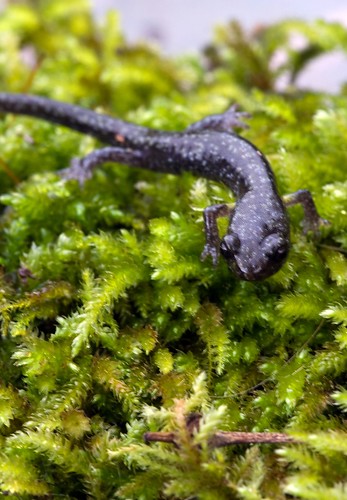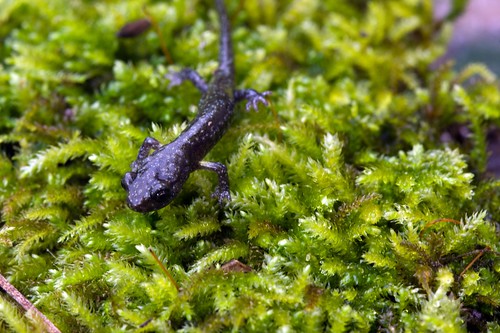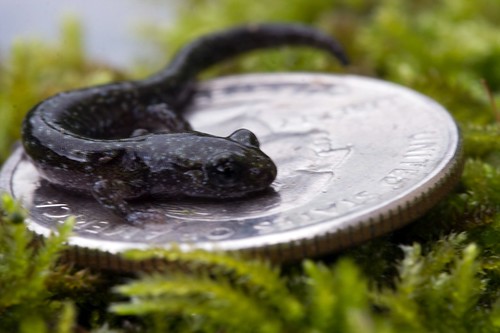As I posted earlier, the weather here in Northern California has been warm and sunny all "Winter" long.
But we finally got a good rain on leap day morning, so that afternoon I headed out to the center of campus for a little 'phib hunt while my model organism did its thang for a few hours.
I flipped a dozen or so Ensatinas in about an hour. All looked about the same and I neglected to put in the effort it takes to snap a photo of a single one.
See my goal was not Ensatina, or Batrachosep, which shockingly I got shut out on, but the elusive Santa Cruz Black Salamander, Aneides niger. I had found juveniles last year and was on the hunt for an adult.
I had given up about 20 rocks ago, but half heartedly flipped a couple dozen more rocks and under the third to last rock I flipped was this little guy. And when I say little, I mean TINY!



This youngster was under a rock that was on very wet dirt. Adults are usually found under rock on rock. However, every (3, small sample size warning) juvenile I have found has been rock on dirt rather than rock on rock.


No adults, so back to the drawing board, but they have to be close by for a baby like this to exist. Might already be too late this year, but the good news is that it was wet enough this season to produce this little guy, so the breeding season was not lost.
I still have not gotten my flash fixed so apologies for the less than perfect long-exposure images, but thought they were still worth sharing.

At my college in Upstate NY, we have a mass migration that occurs annually from uplands, across a busy road, to a wetland below. This year our Wildlife Society club is purchasing Salamander Xing signs to be posted seasonally, as the migration occurs, to make aware local residents to this phenomena. Unfortunately, out "winter" has been similar to yours and we don't know when our 'manders are going to move! Today it's in the teens, by Wednesday in the 60s. Poor little guys and gals!
ReplyDeleteYes signs are a good idea. A portion of road in Tilden Park above the UC Berkeley campus gets shut down every year for the newts. As undergrads that was always a must walk road during the rains. We have a few signs up in Santa Cruz county, but there is not a big migration across any roads in campus as far as I can tell.
DeleteNice find. I used to find them in a seepage running through loose shale right next to the San Lorenzo River near Brook Lomond. The properties are all fenced off now, so you can't get to the river easily without a pit bull on your tail..
ReplyDeleteThe San Lorenzo River must have been an amazing spot back in the day. Salamanders, salmon and trout galore.
DeleteNice. A species I haven't seen yet.
ReplyDeleteA friend of mine lives in Aptos and has multiple salamander crossing signs and tunnels in his area. It's always excellent to drive by one with an outta state visitor. They see them and usually think the signs are put up by hippie locals for fun. When explained the reality (which is basically the same thing, but done through the court and political systems), you often get back a "they're right - you Californians are crazy" look. :)
I found an Aneides lugubris twin to your little niger the other day in my backyard. Same size and spots, but without the yellow armpits, and the color was transparent pink-brown. I put it in a small bucket to take photos later, and it climbed out and got away. So it must have been an arboreal.
Yes the Aptos signs are for the even rarer Santa Cruz long toe salamander. From the researchers I have talked to the tunnels may not be working as well as they had hoped but still early in the study.
DeleteThe first time I found one of these I was not sure I could make the call. The second time, which I now consider the first certain sighting I had John along to help out. But yes very similar but the nigers are black rather than brown and the spots can be really blue almost turquoise where as lugubris ate usually white/cream. Bummer that it escaped, but be on the look out in northern sc county and southern sm county.
Of course happy to show you my spot down here too.
Love the photo on the quarter!
ReplyDeleteThanks BL. Cute overload.
Delete